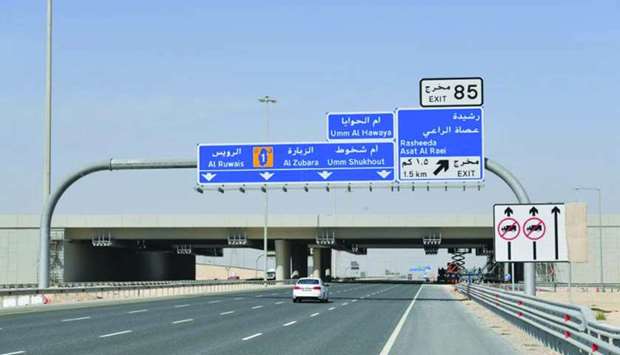With the expected influx of many tourists for the 2022 FIFA World Cup, Ashghal's newly launched ‘Directional Sign Strategy’, will not only make travel in Qatar easier but will also make driving safer for motorists, an official of an international consultancy firm has said. “The objective of the initiative is to enhance the safety of the driver because in some of the roads, motorists can only see the sign at the exit, so they don’t have enough distance to make a decision,” said Garold Adams, the president of Parsons International, which was tapped by Public Works Authority (Ashghal) for the project.
“Now, at least we have three signs before the exit from 1.5km to 1km and then another 500m, so the driver will have enough time and directions to take the proper lane and avoid changing at the last minute,” he told 'Gulf Times'. Adams said Parsons International is comprehensively looking at the entire signage programme of the country and unifying and upgrading it to the highest standards, as well as using top-grade materials, placement, and way-finding techniques, among others.

“It is the first comprehensive, countrywide effort to upgrade Qatar’s signage standards to the best international standards. And there is now an effort from Ashghal considering the fact that there are so many roads opening across the country,” he pointed out.
He added: “If you miss an exit, it would take a longer distance to go back, so the purpose is also to make the route efficient for motorists by preventing them from missing the exits. This makes travel time shorter and safer for both passengers and drivers.”
Adams stressed that the project is a system based on international standards, so that visitors will be able to comprehend and easily use the signage programme. “Considering that Qatar is expecting millions of tourists to arrive for the FIFA World Cup in 2022, it is important to give them proper guidance to the stadiums and other touristic destinations in the country. Without a proper signage system, these tourists won’t have the best experience that we want to ensure them,” Adams stressed.
On the project’s countrywide implementation, Adams said the first priority would be the freeways across Qatar, the design of which is expected to be completed by the end of April. “The city of Doha was divided into four zones, depending on the population and the traffic volume … by the end of the year, we expect all zones to be covered. We’re surveying every single sign on the roads in Qatar and we’re creating a database. We are checking the existing signs with the new standards, modifying them, and adding more signs based on the new signage programme,” he added.

Parsons International president Garold Adams speaking at the launch of Ashghal's newly-launched ‘Directional Sign Strategy’. PICTURE: Shaji Kayamkulam.
“It is the first comprehensive, countrywide effort to upgrade Qatar’s signage standards to the best international standards. And there is now an effort from Ashghal considering the fact that there are so many roads opening across the country,” he pointed out.
He added: “If you miss an exit, it would take a longer distance to go back, so the purpose is also to make the route efficient for motorists by preventing them from missing the exits. This makes travel time shorter and safer for both passengers and drivers.”
Adams stressed that the project is a system based on international standards, so that visitors will be able to comprehend and easily use the signage programme. “Considering that Qatar is expecting millions of tourists to arrive for the FIFA World Cup in 2022, it is important to give them proper guidance to the stadiums and other touristic destinations in the country. Without a proper signage system, these tourists won’t have the best experience that we want to ensure them,” Adams stressed.
On the project’s countrywide implementation, Adams said the first priority would be the freeways across Qatar, the design of which is expected to be completed by the end of April. “The city of Doha was divided into four zones, depending on the population and the traffic volume … by the end of the year, we expect all zones to be covered. We’re surveying every single sign on the roads in Qatar and we’re creating a database. We are checking the existing signs with the new standards, modifying them, and adding more signs based on the new signage programme,” he added.




